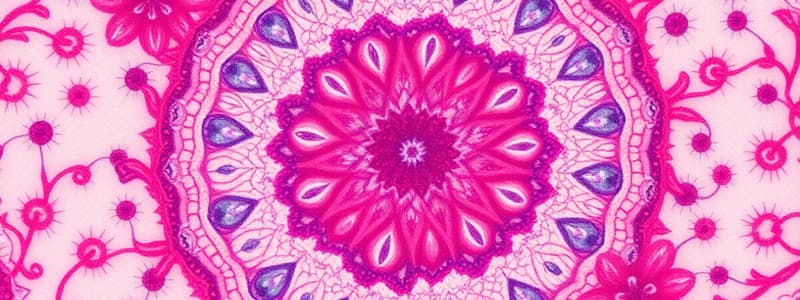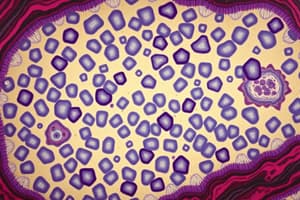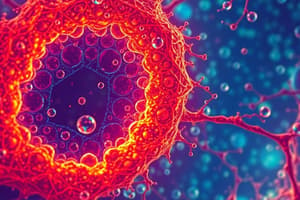Podcast
Questions and Answers
Which component of the cell is considered nonliving and nonessential?
Which component of the cell is considered nonliving and nonessential?
- Endoplasmic reticulum
- Inclusions (correct)
- Mitochondria
- Lysosomes
What is the study of tissues and their arrangement in organs called?
What is the study of tissues and their arrangement in organs called?
- Cytology
- Histology (correct)
- Pathology
- Anatomy
What model describes the structure of the cell membrane?
What model describes the structure of the cell membrane?
- Unit membrane model
- Fluid mosaic model (correct)
- Lipid bilayer model
- Phospholipid monolayer model
Which of the following is NOT classified as an organelle?
Which of the following is NOT classified as an organelle?
Which of the following is a type of passive transport?
Which of the following is a type of passive transport?
What is the primary characteristic of the cell membrane?
What is the primary characteristic of the cell membrane?
What distinguishes receptor-mediated endocytosis from other forms of endocytosis?
What distinguishes receptor-mediated endocytosis from other forms of endocytosis?
What is the function of exocytosis?
What is the function of exocytosis?
Flashcards
Histology
Histology
The study of tissues and their arrangement to form organs, primarily using microscopes.
Hyaloplasm (Cytosol)
Hyaloplasm (Cytosol)
The clear, colloid solution within a cell's cytoplasm, containing enzymes, proteins, and nutrients.
Organelles
Organelles
Living, organized components within a cell responsible for essential functions.
Inclusions
Inclusions
Signup and view all the flashcards
Cell Membrane
Cell Membrane
Signup and view all the flashcards
Active Transport
Active Transport
Signup and view all the flashcards
Endocytosis
Endocytosis
Signup and view all the flashcards
Exocytosis
Exocytosis
Signup and view all the flashcards
Study Notes
Histology
- Study of tissues and its arrangement to form organs
- Relies on microscopes
The Cell
- Eukaryotic
- Cytoplasm
- Hyaloplasm (cytosol)
- Clear colloid solution
- Contains:
- Enzymes
- Protein
- Nutrients
- Suspended bodies
- Organelles
- Inclusions
- Hyaloplasm (cytosol)
Organelles
- Living, organized, essential for cell function
- Membranous organelles
- Cell membrane
- Mitochondria
- Endoplasmic reticulum
- Golgi apparatus
- Lysosomes
- Non-membranous organelles
- Ribosomes
- Microtubules
- Filaments
Inclusions
- Nonliving, non-organized, non-essential for cell function
- Pigments
- Exogenous
- Dust
- Tattoo
- Endogenous
- Hemoglobin
- Melanin
- Exogenous
- Stored food
- Glycogen
- Fats
Cytoskeleton
- Microtubules
- Microfilaments
- Intermediate filaments
Cell Membrane (Plasma Lemma)
- Thinnest layer surrounding the cell (8-10nm)
- Light microscope: Can't be seen
- Electron microscope:
- Trilaminar (unit membrane)
- Outer electron dense
- Inner electron dense
- Intermediate electron lucent
- Trilaminar (unit membrane)
- Filamentous layer on the outer aspect: Cell coat
Fluid Mosaic Model of Cell Membrane
- Explains the membrane structure and function
Functions of the Cell Membrane
- Transport between intracellular and extracellular environments
- Passive transport
- Simple diffusion
- Facilitated diffusion (channels)
- Active transport
- Pumps
- Against concentration gradient
- Requires ATP
- Bulk (vesicular) transport
- Endocytosis (intake)
- Exocytosis (release)
Endocytosis
- Engulfment of material from the external environment
- Phagosome
- Vesicle containing solid material
- Lysosome
- Digests material within the vesicle
- Pinocytosis
- Takes in fluids
- Receptor-mediated endocytosis
- Specific binding of molecules before uptake
Exocytosis
- Fusion of vesicles with the cell membrane and release of contents into the extracellular fluid
Studying That Suits You
Use AI to generate personalized quizzes and flashcards to suit your learning preferences.




